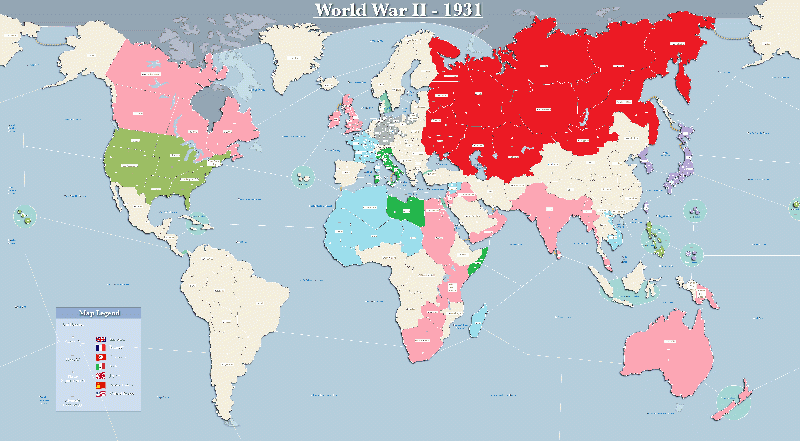WW2-1931
A Diplomacy variant by Nick Higgins
BACKGROUND
My goal is to create a global WWII-era variant for Diplomacy that attains the elusive perfect balance between history and gameplay. My hope is that the variant will play "smaller" than its size. Every player on the board has reason to interact with virtually every other player. Conceptually, the variant is built around numerous diplomatic triangles, as triangles are generally the most dynamic configuration in Diplomacy.
Offensive play is encouraged in many ways. First, there are no corner positions, which limits the effectiveness of defensive tactics. Chokepoints are kept to a minimum. "Chaos builds" ensures that players are not waiting for years to move units to the front lines. Aerial units are far more useful in attack than defense, and should be helpful in breaking any potential stalemate lines. Finally, a relatively short victory line (1/3 instead of 1/2 of the total SCs) should encourage players to go for the solo victory, instead of the alternative where players decide that victory is impossible on such a large map, and then play for the draw.
I welcome any feedback on the variant. Please contact me at congressofvienna1814@yahoo.com.
RULES
- There are 7 players:
- Britain (B, 9)
- France (F, 8)
- Germany (G, 7)
- Italy (I, 7)
- Japan (J, 6)
- USA (A, 6)
- USSR (S, 8)
- Neutral (38)
- There are 89 supply centers, with 39 in Europe, 34 in Asia, 9 in the Americas, and 7 in Africa.
- The victory condition is 30 SCs (one-third of the total).
- There are chaos builds, meaning that units can be built in any open supply center.
- There are two new types of units: planes and aircraft carriers. These units do everything with a strength of 0.5, including movement, support, and defense. To compensate for this weakness, they can support actions that are two spaces away. See the section "Aerial Units" below for more details.
- For a plane unit, use the abbreviation P (e.g. P Gor S A Mos - Pol). For an aircraft carrier unit, use the abbreviation Q (e.g. Q Liv S F Lon - Eng).
- Denmark, Kiel, Turkey, Suez, and Panama are all canal provinces. This means that both an army and a fleet can move through these spaces.
- Any unit can move across the "yellow dashes". However, a unit cannot retreat across a "yellow dash". "Yellow dashes" connect the following pairs: Scotland and Ireland, Iberia and Casablanca, Taranto and Sicily, Abyssinia and Yemen, Yemen and Iran, Kyoto and Hokkaido, Hokkaido and Sakhalin, Sakhalin and Vladivostak, and Kamchatka and Alaska.
- Neutral units hold every turn. Any neutral unit that is dislodged is immediately disbanded. If a neutral unit is disbanded in Spring and then the SC is vacated after Fall, then the neutral unit is rebuilt during Winter.
- Denmark borders Oslo, and an army can move from Denmark to Oslo. Essentially, Denmark comprises both Denmark and Skagerrak from Standard Dip.
- Gray water spaces in the Arctic areas are impassable.
AERIAL UNITS
First, some examples.
Example 1: German A Bavaria and Italian P Venice both move to Switzerland. A Bavaria succeeds (1.0 > 0.5), and P Venice bounces.
Example 2: German A Switzerland attacks the Italian P Venice. A Switzerland succeeds (1.0 > 0.5).
Example 3: German P Berlin supports Italian A Venice to Switzerland, with a neutral army in Switzerland. A Venice succeeds (1.5 > 1.0).
Example 4: In example 3, French P Paris supports A Switzerland. The Italian army bounces (1.5 = 1.5).
Example 5 ("half-cut", see more below): German A Bavaria supports Italian P Venice to Switzerland, which is occupied by a neutral army. French P Burgundy moves to Bavaria, "half-cutting" the support to 0.5. The attack fails (1.0 = 1.0).
Now, some clarifications in response to potentially unclear issues.
- If an aerial unit (P or Q) attacks to cut the support standard unit (A or F), then it is only a "half-cut" that reduces the amount of the support from 1.0 to 0.5. Two aerial units can combine to fully cut the support of the standard unit.
- Just like their sea-unit counterparts (fleets), aircraft carriers can convoy land units (both armies and planes). The convoyed unit attacks with its usual strength (armies = 1.0, planes = 0.5).
- Just like their land-unit counterparts (armies), planes cannot convoy units.
- Aerial units can occupy SCs. For example, P Saxony can occupy the Sudentenland.
- Aerial unit support can be projected across map spaces regardless of the composition (land or sea) of the space. For example, Q San Francisco can support F Washington DC to Gulf of Mexico.
